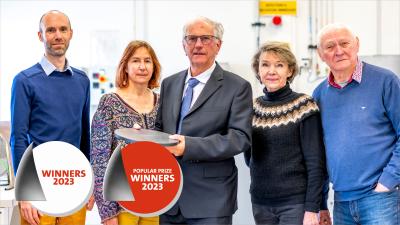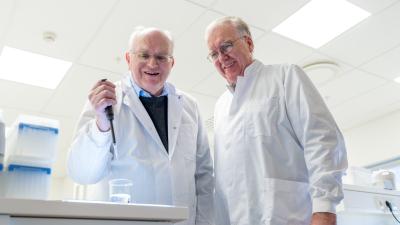Harald Haas and team
High-speed internet through LED lights
Finalists for the European Inventor Award 2023
With global interest steadily growing, Haas is optimistic about the potential of his team’s work: “We are going through a phase where radio communications, if we look at 6G, requires a new spectrum because the currently allocated radio spectrum is simply not enough. The optical spectrum resource is around 3 000 times larger than the entire radio spectrum... We already have light devices and light detectors which can be used to build terabit per second LiFi networks. There is a huge ocean in front of us that we want to leverage for mobile communications. We only need to step out of the crowded pool.”
Lighting up mobile communications
Haas earned an engineer’s degree from Nuremberg Institute of Technology and worked in mobile communications before receiving his PhD from University of Edinburgh in 2001. He later worked as an associate professor of electrical engineering at Jacobs University in Bremen, Germany, before moving to Scotland, where he furthered his research into wireless communication using light waves.
In 2011, his research achieved a major turning point: he delivered a Ted Talk in which he streamed a YouTube video through the light waves emitted by a tabletop lamp. The talk, “Wireless Data from Every Light Bulb” introduced his invention to the world and has been viewed more than 2.7 million times. Haas has published more than 630 research papers and his research has been reported by international media including BBC, The New York Times and Time Magazine, which named LiFi one of the best inventions in 2011.
Haas founded pureLiFi in 2012 as a spin-off from The University of Edinburgh. The company has to date raised EUR 37.9 million in venture capital and already markets the world’s first commercial light antennas for various devices including AR/VR headsets and smartphones. It also offers LiFi systems for customers seeking to augment, enhance or transform their wireless networks. Haas and his team are targeting “a global roll out of our revolutionary technology,” with the market for LiFi expected to be worth EUR 7.7 billion by 2030.
Media gallery
Patent numbers:
Press materials
Access materials for journalists
Press release: Wireless connections 100 times faster than Wi-Fi: German researcher selected as a finalist for the European Inventor Award 2023 Press photos/videos (for MXF format videos, please contact press@epo.org)
Contact
European Inventor Award and Young Inventors Prize queries:
european-inventor@epo.org Subscribe to the European Inventor Award newsletterMedia-related queries:
Contact our Press team#InventorAward #YoungInventors






